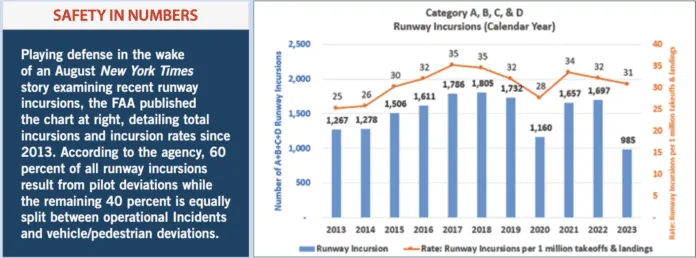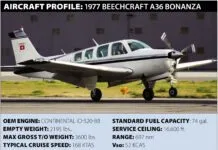July 1, 2023, Cedar Rapids, Iowa
Berkut 540 Experimental
At about 0853 Central time, the airplane was substantially damaged when it was force-landed on a road after engine failure. The solo pilot was not injured.
During initial climb, at around 3400 feet msl, the pilot realized the engine had lost partial power. Fuel pressure, fuel flow and manifold pressure were nominal, and the pilot opted to return for a landing. When the pilot activated the fuel boost pump, the engine lost all power. He chose a gravel road to land on. Touchdown was normal, but a bump caused the airplane to veer left, and the wing impacted a road sign. The airplane came to rest upright in a residential driveway; the left and right wings were separated, the left canard was damaged and the right landing gear had collapsed. The pilot reported this was the first flight of the experimental airplane.
July 2, 2023, North Myrtle Beach, S.C.
Piper PA-32R-300 Lance
The airplane was destroyed at 1102 Eastern time when it failed to climb after takeoff, stalled and then spun, colliding with terrain. The private pilot and four passengers were fatally injured.
After the airplane arrived three days earlier, it was fully refueled. Surveillance video recorded a portion of the airplane’s takeoff, and showed it in a shallow climb, with a nose-high pitch attitude, until it was out of the camera’s view. A witness observed the airplane’s angle-of-attack increase significantly but then appear to decrease momentarily and repeatedly, with small gains in altitude each time. There were no visible or audible indications of engine issues. As the airplane continued the takeoff, it turned right at a low altitude and slow speed, without gaining additional altitude. It then leveled and veered right for approximately 10-15 seconds, while maintaining a high angle-of-attack. Subsequently, the right wing “stalled” and the witness observed the underside of the airplane as it quickly descended to the ground in a right turn. A post-impact fire erupted.
July 2, 2023, Old Harbor, Alaska
Piper PA-32-300 Cherokee Six 300
At about 1510 Alaska time, the airplane sustained substantial damage when it collided with terrain. The pilot and one passenger sustained serious injuries, one passenger suffered critical injuries and two passengers were fatally injured. Weather for the FAR Part 135 on-demand air taxi flight included eight miles of visibility under a 1400-foot broken layer. A company VFR flight plan had been filed.
According to the pilot, as the flight approached rising terrain, he determined he needed to gain altitude to clear a 950-foot-high mountain pass. He said he believed the airplane was in a downdraft and wouldn’t climb. Out of options, “he selected an area of mountainous, uneven, alder-covered terrain as a forced landing site.” The airplane came to rest at an elevation of about 750 feet msl.
July 4, 2023, Aliceville, Ala.
Steen Skybolt Experimental
The airplane was substantially damaged at about 0900 Central time in an off-field landing following engine failure. The solo pilot was not injured.
According to the pilot, the airplane had been “sitting for several years” when he purchased it two years earlier. After maintenance and repairs, plus engine and taxi tests, he was ready to fly it. On the day of the accident, he flew two test flights, including one in ground effect. As the pilot attempted to push in the carburetor heat control after a takeoff, the knob stuck in the ON position, presumably with some loss of engine power. He made a “real easy left turn” back to the runway. During the turn, the engine stopped producing power. A forced landing into trees followed, with the airplane coming to rest in swampy terrain.
July 4, 2023, Redstone Arsenal, Ala.
Grumman American AA-5A Cheetah
At about 1045 Central time, the airplane was substantially damaged when it was force-landed on a road after engine failure. The private pilot and pilot-rated passenger were not injured.
While en route to a nearby airport at 3500 feet msl, engine power dropped to what the pilot described as a “high idle” and would not respond to throttle input. When it became apparent the airplane would not reach the divert airport’s runway, he selected a nearby paved road for landing, during which the left wing hit a metal pole. Examination revealed the throttle control cable’s outer assembly was lacking the clamp, shim, screws and self-locking nuts that secured it in the engine compartment. Records revealed the throttle cable was replaced at the airplane’s last annual inspection, approximately nine flight hours previous.
July 4, 2023, Murrieta, Calif.
Cessna 172N Skyhawk
The airplane was substantially damaged at about 1357 Pacific time during an attempted go-around. The pilot was fatally injured while the three passengers suffered serious injuries.
A witness reported the airplane’s approach to Runway 18 with what appeared to be full flaps deployed was “unstable.” Surveillance video showed the airplane touching down on the runway, rolling for 1-2 seconds and then entering a climb in a nose-high attitude as it drifted left of the runway centerline. On reaching about 60 feet agl, it began to settle and subsequently entered a left-wing-low attitude before rolling inverted and disappearing from view behind a building. The witness reported the flaps seemed to be retracting as the airplane disappeared behind the building and the engine was operating at high power.
July 8, 2023, Murrieta, Calif.
Cessna 550 Citation II
At about 0414 Pacific time, the airplane was destroyed during its second approach to the destination airport when it collided with terrain short of the runway. The two pilots and four passengers were fatally injured. Instrument conditions prevailed; an IFR flight plan was in effect.
About 58 miles north of the destination, the crew began a descent and cancelled IFR clearance. Shortly, they reported receiving updated weather and requested an IFR clearance for the RNAV approach to Runway 18. Preliminary ADS-B data show the airplane descended to the procedure’s decision altitude (DA) of 1600 feet msl before executed a missed approach. The crew requested and was cleared for another try at the approach but descended below the DA; the last recorded ADS-B data point showed the airplane at about 1450 feet msl and about 128 knots groundspeed. The airplane impacted terrain about 800 feet short of Runway 18’s threshold.
At 0335, the automated weather at the destination included clear skies and visibility of 10 sm. Twenty minutes later, there was an overcast ceiling at 300 feet and visibility of ¾ sm. By 0411, visibility had dropped to 1/2 sm in fog.
July 8, 2023, Sherman, Texas
Piper PA-30 Twin Comanche
The airplane was substantially damaged at about 0941 Central time when it impacted terrain under unknown circumstances. The solo pilot sustained fatal injuries.
While en route on the 26-nm flight, the accident airplane was observed making four orbit turns of at least 360 degrees; three turns were to the right and one was to the left. Completing the fourth orbit (to the right) about six miles southeast of the destination, it then began a shallow descent. Shortly, when the airplane was 13 miles east of the destination and descending through 3800 feet msl, it turned to southwesterly and westerly headings. The last ADS-B data point showed the airplane at less than 100 feet agl and at about 61 knots groundspeed.
Examination of the wreckage revealed both propellers displayed minimal indications of scoring or rotational energy. None of the propeller blades were feathered. About nine gallons of fuel were recovered from the left fuel tank and about 11 gallons from the left auxiliary tank; about nine gallons were recovered from the right main fuel tank and about three gallons from the right auxiliary. The left engine fuel selector was OFF; the right fuel selector was positioned to MAIN. Fuel in the right fuel selector contained multiple rust flakes and a bead of water. When the right fuel selector was tested with low air pressure, there was a partial blockage to the right auxiliary fuel tank port, and air could pass through that port when either the OFF or MAIN positions were selected.
July 13, 2023, Osage Beach, Mo.
Piper PA-28-140 Cherokee 140
At about 1157 Central time, the airplane sustained substantial damage when it failed to gain altitude after liftoff. The pilot and one passenger sustained fatal injuries; one passenger was seriously injured.
Shortly after the takeoff, witnesses observed the airplane’s tail was lower than its nose. The witnesses reported the airplane “banked” to the right and impacted a heavily wooded area on private property, about 0.55 miles from the runway’s departure end. The trim tab jackscrew position corresponded to a full nose-up trim setting. The estimated density altitude was 3205 feet, more than 2000 feet higher than field elevation.
July 15, 2023, Vineyard Haven, Mass.
Piper PA-46-500TP Malibu Meridian
The airplane was substantially damaged at 1515 Eastern time after its pilot experienced a medical emergency during a go-around. The non-pilot-rated passenger landed the airplane gear-up. The 79-year-old pilot was fatally injured, and the passenger sustained minor injuries.
The pilot’s most recent FAA medical certificate was issued June 1, 2023. According to the NTSB, “Previously, the pilot had been granted a third class, special issuance medical certificate which required that the pilot supply extensive documentation of his health conditions as requested by the FAA.”
July 20, 2023, Kearney, Mo.
Piper PA-31P Pressurized Navajo
At about 0934 Central time, the airplane was destroyed when it failed to gain altitude after takeoff. The pilot sustained fatal injuries.
According to multiple witnesses, the airplane’s most recent annual inspection was performed in 2015. The owner and a mechanic worked on the airplane for about six months to prepare it for the ferry flight. Two witnesses reported the right engine was difficult to start and would not produce full power. They also reported the inboard fuel tanks leaked “horribly” and that three pilots declined to perform the ferry flight.
Before the accident flight, the airplane was fueled to its 140-gallon capacity. Multiple video recordings showed the airplane veer right and attempt to lift off before settling back to the runway. The airplane became airborne near the runway’s end and yawed to the right before barely clearing trees. A witness about 1.60 nm north of the airport observed the airplane strike two static wires on a power transmission line before it impacted a tree canopy and then a nearby soybean field.
July 24, 2023, Churchville, Md.
Piper PA-28R-200 Arrow II
The airplane was substantially damaged at about 1906 Eastern time when it impacted terrain shortly after takeoff. The solo commercial pilot was fatally injured.
Before taking off, the accident pilot told a mechanic he was going to fly around the airport traffic pattern a few times in preparation for an upcoming cross-country flight. A witness heard the accident airplane begin its takeoff run at about 1905, reporting that the engine sound was constant. Another witness reported seeing the airplane in a steep left bank “with the wings perpendicular to the ground” and stated that the airplane was extremely low compared to airplanes that normally flew over his house.
The airplane came to rest about ½-mile from the departure end of the takeoff runway. All major components of the airplane were found at the accident site. The flap handle was found in the fully extended position, and the landing gear switch was found in the down position. The accident flight was the first since an annual inspection was completed the same day. Additional work accomplished during the annual inspection included installing a new propeller and interior.




